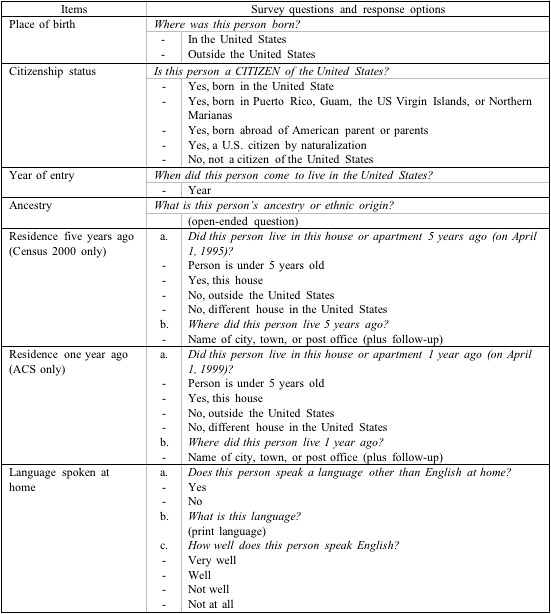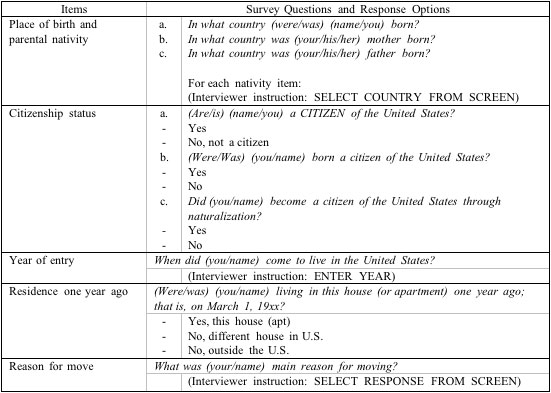Data Sources on the Foreign Born and International Migration at the U.S. Census Bureau
The foreign-born population of the United States is at its all-time numeric high, numbering over 31.1 million (for a definition of the foreign born, see Box 1). The rapid and substantial growth of this population has intensified interest in immigration and immigration-related issues. This article addresses three of the primary data resources from the U.S. Census Bureau used to study immigrants in the United States and to better understand the immigration experience. These resources include the decennial census, the American Community Survey (ACS), and the Current Population Survey (CPS).
|
Box 1: Defining the "foreign born"
|
|||
|
Decennial Census
Taken once every ten years, the census is the primary source for demographic, social, and economic information on the foreign born in the United States (see Box 2). Not only is it currently the most comprehensive tool available for studying immigrants, it is unique in that it provides the sole means by which to study small groups of the foreign-born population (e.g., German, Hmong, Fijian) at the national and detailed sub-national (i.e., state, county, and sub-county) levels.
|
Box 2: Census facts
|
|||
|
Since the 1950 census, international migration-related information has been derived from "sample" data. For Census 2000, sample questions were asked of approximately one-sixth of the population, on the census "long form" (for an explanation of the terms "sample data" and "long form" see Box 2). The resulting sample data was used to generate estimates for the entire resident population, including people in group quarters (e.g., nursing homes, college dormitories, etc.) (see Box 3).
|
Box 3: Short forms, long forms, and sample data
|
|||
|
Items related to the foreign born and international migration on the Census 2000 questionnaire included place of birth, citizenship status, year of entry, ancestry, residence five years ago, and language spoken at home. Table 1 below lists the migration-related questions asked in the 2000 decennial census.
A notable omission from the most recent censuses is parental nativity (birthplace of parents), asked each census year since 1870, but discontinued after the 1970 census. Starting in the 1980 census, a question on ancestry (based on self-identification) replaced the question on birthplace of parents.
The Census Bureau makes every effort to ensure the quality of the foreign-born data. To better reach foreign-born respondents, the Census 2000 questionnaires were translated into five languages (Spanish, Chinese, Vietnamese, Korean, and Tagalog). To assist individuals who are more proficient in languages other than English, language guides were provided in 49 other languages.
American Community Survey
In order to improve accuracy and contain costs to the taxpayer, the Census Bureau plans to re-engineer and simplify future censuses. Traditionally, the Census Bureau has conducted a complete count of the population using the "short form" and, for a sample of the households, collected socioeconomic and demographic characteristics of the population using the "long form." For the next census in 2010, the American Community Survey (ACS) is intended to replace the long form. The ACS will collect long-form-type socioeconomic and demographic data each year throughout the decade rather than once every 10 years.
Currently, the Census Bureau is developing and testing the ACS methods to provide accurate and detailed data. When all testing programs are completed, the Census Bureau anticipates full implementation of the ACS in 2003, contingent on congressional funding. The survey will eventually include an annual sample of three million housing units, including populations in group quarters.
Once fully implemented, the ACS will provide timely demographic, housing, social, and economic data every year for all states, as well as for all cities, counties, metropolitan areas, and population groups of 65,000 people or more. Multi-year averages will be used to produce estimates for geographic areas and population groups of fewer than 65,000 people (see Box 4). This includes many of the smaller foreign-born groups.
|
Box 4: Annual and multi-year sample averages in the American Community Survey
|
|||
|
The annual release of ACS data, available at detailed sub-national levels of geography, will provide a wealth of information never before available in an ongoing and timely manner from either decennial censuses or smaller sample surveys. When fully implemented, the ACS will provide the detailed demographic data traditionally collected on the decennial census long form and will enable the 2010 Census to collect only short form information.
The migration and foreign-born related questions that were asked in Census 2000, including place of birth, citizenship status, year of entry, ancestry, and language spoken at home, are also asked in the ACS (see Table 1). Previous residence, in the form of "residence one year ago," is asked in the ACS instead of the "residence five years ago" asked in the decennial census.
Currently, the ACS paper version of the questionnaire is only available in English. Computer Assisted Telephone Interviews (CATI) and Computer Assisted Personal Interviews (CAPI) are conducted in both English and Spanish, where needed.
|
Table 1: Questions asked in Census 2000 and in the American Community Survey related to international migration and the foreign born
|
|||
|
Current Population Survey
In addition to the decennial census and the ACS, national surveys such as the Current Population Survey regularly ask questions useful to the analysis of international migration. The CPS is an interview-administered, monthly survey of approximately 60,000 households conducted by the Census Bureau for the Bureau of Labor Statistics.
The main purpose of the CPS is to collect information on the labor force characteristics of the U.S. population -- specifically, to assess monthly unemployment changes. The sample is scientifically selected to represent the civilian non-institutional population. Respondents are interviewed to obtain information about the employment status of each member of the household 15 years of age and older. However, published data focus on those ages 16 and over. Unlike research based on Census 2000 and ACS data, with their sizeable sample populations, robust analyses of CPS data are generally restricted to the national level and to select smaller geographic areas with sizeable populations (e.g., large states such as California and New York).
In the CPS, two sets of questions are asked of respondents: a) the basic monthly questions and b) the supplements. The basic CPS collects labor force and demographic information. Since 1994, the basic CPS also has included questions on nativity of respondent and parental nativity, citizenship status, and year of entry into the United States. The March (Annual Demographic) supplement includes questions about poverty status, money income received, health insurance, household and family characteristics, marital status, and geographic mobility in the previous 12 months (including moves from abroad).
For studying the foreign born, researchers rely primarily on the March CPS data due to the increased sample size of about 2,500 eligible housing units containing at least one individual of Hispanic origin. Because the foreign-born related items are located on the basic (monthly) questionnaire, studies of the foreign born can also be conducted using averaged monthly files. Table 2 lists the international migration-related items regularly found in the CPS since 1994.
Throughout the 1980s, the Census Bureau collected intercensal data on the foreign born by including supplements to the CPS. These supplements were fielded in April 1983, June 1986, June 1988, and November 1989.
The CPS survey questionnaire is currently available in both English and Spanish, where needed.
|
Table 2: Questions asked in the Current Population Survey related to international migration and the foreign born
|
|||
|
Differences Between Census and CPS Estimates
Important differences exist between estimates of the foreign-born population from the decennial census and those from the March CPS. While the universe for the census is the entire U.S. resident population, the universe for the March CPS is the civilian non-institutional population. Foreign-born individuals living in group quarters or institutions such as nursing homes or prisons are not included in the CPS count as they are housed in facilities not covered by the CPS.
Also, the primary data collection method for the CPS is different from that used in Census 2000. The CPS is an interviewer-administered survey, with data being gathered through in-person or telephone interviews. The data from Census 2000 were collected primarily through a mail-out/mail-back questionnaire. In the interviewer-administered format, respondents may ask the interviewer for his/her opinion as to how they should reply to a given question, and the interviewers have been trained to provide clarification where applicable. The mail-out/mail-back format used to collect Census 2000 data did not provide this additional clarification. This is significant, because these differences in the collection process mean that CPS and Census 2000 data are not entirely comparable.
Other Data Sources
Migration-related data are available from several other government surveys, including the Survey of Income and Program Participation (SIPP), the National Health Interview Survey (NHIS), the New York City Housing Vacancy Survey (NYCHVS), and the American Housing Survey (AHS). Although these surveys include some migration-related questions not found in the decennial census, ACS, and CPS, their use for studying the foreign born is restricted by their relatively small sample sizes.
Additional Information
Much of the information presented in this article is adapted from the Guide to International Migration Statistics: The Sources, Collection, and Processing of Foreign-Born Population Data at the U.S. Census Bureau, by J. Costanzo, C. Davis, and N. Malone (Population Division Working Paper #68, U.S. Census Bureau, 2002). The report includes additional detailed information about the sources of foreign-born data as well as data processing and editing. The report in its entirety is available on the Census Bureau website.
Additional Resources
Gibson, C. and E. Lennon. 1999. Historical Census Statistics on the Foreign-born Population of the United States: 1850 to 1990. U.S. Census Bureau, Population Division Working Paper no. 29. This report is available online.
Gauthier, J.G. 2002. Measuring America: The Decennial Census From 1790 to 2000. POL/02-MA, U.S. Census Bureau, Washington, DC.
Schmidley, A.D. 2001. Profile of the Foreign-born Population in the United States: 2000. U.S. Census Bureau, Population Division, Current Population Reports, Special Studies, P23-206. This report is available online.
"The American Community Survey (ACS)." Available online.




